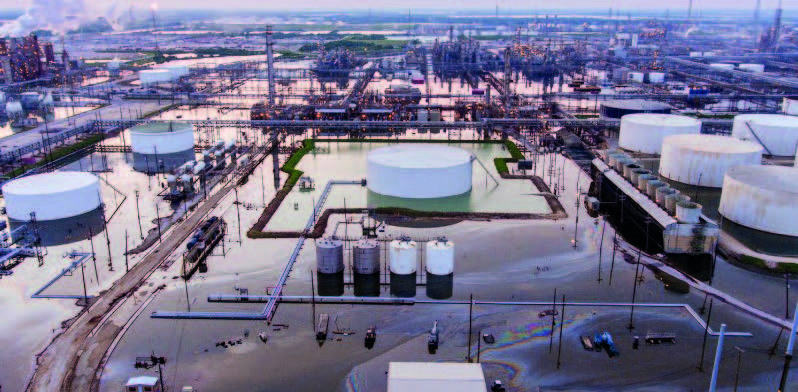When considering the impact of a natural disaster, the foremost consideration is the impact to people in the region. The cost of lives and damage to private property. School closures, stifled food supplies and limited or restricted access to public areas are just a few common consequences of natural disasters. This ‘human impact’ is the picture portrayed in the media and the narrative that is projected to the wider world. A disruption in the energy supply similarly has a widespread effect on every aspect of life from turning the lights on at home to powering hospitals.
By Foster Voelker, Director of Engineering – William E. Williams Valve Corporation and Mike Dunn, Co-Owner – JS Machine and Valve Inc.
The impact of circumstances such as natural disasters, can significantly impact the operation and safety of oil refineries and power plants. These effects can be particularly adverse and dangerous for those containing toxic materials and hazardous chemicals which could further impact the environment and residents surrounding the area. Production is halted, supply is limited and, as was seen in the case of Hurricane Katrina, damage can be widespread and long lasting. Lessons have been learned since instances like Hurricane Katrina, and now there is legislation and frameworks in place to help prepare for such disasters.
However, this raises the questions, is this legislation fit for purpose? Does it help the energy industry effectively plan for a natural disaster to reduce the impact of a disruption on production and limit the damage caused by uncontrolled hazardous materials? Standard Operating Procedures in petrochemical plants cover preparedness in the event of an emergency, but do they effectively deal with the enormity of damage that could be caused by an earthquake, flood, or fire? Examples throughout history have dictated that work needs to be done proactively, to anticipate these emergencies, rather than reactively and risk
situations worsening.
Examples of Natural Disasters That Could Affect the Oil and Chemical Industry
The U.S. is no stranger to natural disasters affecting its oil refineries and energy supplies. California is home to 15 operating oil refineries and is one of the most predictable areas for earthquakes. In 2019 a major earthquake caused two large ethanol tanks to catch fire and a local evacuation was executed. As hazardous materials and particulates filled the air, the impact was both immediate in terms of human safety, and long lasting, in terms of the disruption caused by
halting refinery processing.
However, earthquakes are not the only natural disaster to affect refineries, power plants and petrochemical stations. Flooding due to storms, hurricanes, or tsunamis can cause major disruption and destruction including (but not limited to) damage to equipment or floating storage tanks, structural damage or failure, floating oil in the drainage systems, and power outages. A short circuit or power failure can shut down units that are left running during these events, including steam boilers, cooling towers, pumps, and electrically operated safety control mechanisms.
An additional risk to refineries and tank farms is lightning strikes. The average home in the U.S. has a 1-in-200 chance of being struck by lightning every year, meaning that a power plant, refinery, or tank farm of an immeasurably larger scale not only carries the risk of a lightning strike, but the damage is likely to be far greater. One such example is that of the Chevron El Segundo Lightning Strike. In 2019 lightning struck the Sulphur Acid Division of the refinery, causing a power dip across the entire plant and a total outage in the sulphur unit. Electric pumps were affected, furnace-induced draft fans were out of action and overhead systems were offline. The only thing that helped to avoid any major safety risks was the recovery plan that Chevron had in place. By creating a natural disaster preparedness plan, specific parts of the system were prioritised to reduce the risk of an explosive environment, avoid flaring, and to avoid loss of flow in critical applications.

Current National Response Framework Legislation
Natural disaster preparedness is not simply a robust set of Standard Operating Procedures. It should be a requirement of each plant and refinery to have a plan in place for any and all eventualities, in order to reduce the risk of explosion or environmental hazard, and to minimize the disruption to production and supply.
In 2014 the National Petroleum Council pushed for legislation that would help the petroleum industry build resilience against the impact of a natural disaster. The National Response Framework was borne to provide a robust system working with government agencies, departments, and responders at the local, state, and federal levels to interact with the industry to respond to all types of disasters and emergencies. This framework helps everyone involved to exchange information, allocate resource distribution, and enable decision-making in the event of an incident. Designed to help develop communication between oil companies, the government, and local sectors, the National Response Framework goes much further than the current ICS (Incident Command System) which acts as a template for any industry to manage an incident or disaster on a multitude of levels.
In addition to the legislation, each refinery, power plant, and pipeline should have a clear plan in the event of a natural disaster which is tailored to their specific systems, machinery, and units. By acting in an efficient, methodical manner, not only will the risk of explosion be reduced, but the risk of internal costly damage within the plant will be lowered.

Case Study: Japan
In 2021, a hugely powerful earthquake in north-eastern Japan knocked out power, disrupted travel (the bullet train lines were severely affected) and injured more than 150 people. The refinery most affected, Eneos Corp, was forced to shut down, cutting the country’s power supply
by 20%.
The Eneos Corp processes as much as 743,000 barrels of oil per day. The refinery near Sendai, situated nearby the epicentre of the 7.3 magnitude earthquake, had to be shut down immediately. A second refinery, near Negishi, was also shut down, causing an overall shortage of 415,000 barrels per day. The refineries were closed for four days and following rigorous checks were reopened to help alleviate the shortage of oil.
Case Study: Hurricane Harvey
In 2017 Hurricane Harvey hit the Texas Gulf Coast, an area that is home to 47 oil refineries and accounts for 4.944 million barrels per day of refinery capacity. Refineries and chemical complexes such as ExxonMobil in Baytown, Shell in Deer Park, and Phillips in Sweeny were shut down due to the immense flooding being caused by the hurricane. The major Texas Gulf Coast ports of Corpus Christi and Houston were closed to vessels, making crude oil and chemical imports impossible to dock and therefore creating a huge impact to the production line. Pipelines BridgeTex and Longhorn, which carry around 675,000 barrels of oil per day were also shut down as well as the Kinder Morgan Crude and Condensate line. These closures reduced the production of oil in the Gulf Coast by 21.64% while natural gas output was affected by 25.71%.8 Government agencies such as the US Bureau of Safety and Environmental Enforcement, the US Environmental Protection Agency, and the Texas Commission on Environmental Quality were all key players in the reopening of the plants and refineries, offering waivers for parts of Texas bound by the Clean Air Act to use reformulated fuels in order to increase production post shutdown. Supply through pipelines was marginally impacted, however this was minimised due to an already existing backlog of gasoline prior to the shutdown. The financial effect of this shortage meant that while crude oil prices remained stable, gasoline rose by 7%.
Final Thoughts
With the economic impact of natural disasters increasing, due to human progress and development, it is increasingly important that individuals plan, prepare, and protect oil refineries and power plants from impending danger. As the highly hazardous and toxic materials being handled carry significant environmental risks, it is each plant’s duty to prepare for every natural disaster in order to reduce the risk to others. A natural disaster preparedness plan should be utilized, not just to reduce risk, but to bolster the industry against any and all eventualities.

Mike Dunn is an alumnus of Northeastern State University, receiving a Bachelor of Science in Management Information Systems. However, deviating from the most obvious professional path, Mike decided to uphold the family legacy and enter the illustrious valve repair industry. Almost two decades later, Mike is the co-owner of JS Machine and Valve Inc., a premier valve refabrication facility located in Nowata, Oklahoma, and has been involved in the development of several patented products. Due to this extensive experience in refabrication, Mike has a unique insight into common valve related failure modes and the implications thereof.

Foster Voelker II attended the University of Houston, receiving a degree in Mechanical Engineering. After graduation, Foster Voelker began his career as a valve engineer for a large commodity valve manufacturer. During his tenure at this company, he helped to implement a fugitive emission compliance program across several product lines. Foster continued his focus on FE compliance as a project manager for a domestic manufacturer of seal components, helping both OEM valve manufacturers and end users conform to current emissions and regulatory requirements. After which, Foster returned to the valve production sector, consolidating these years of experience as the Director of Engineering for William E. Williams Valve Corporation.


